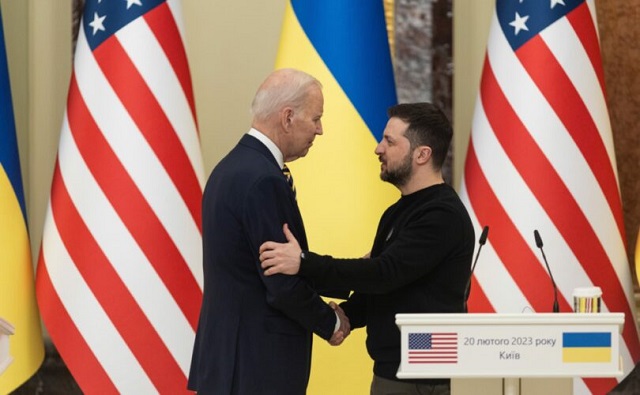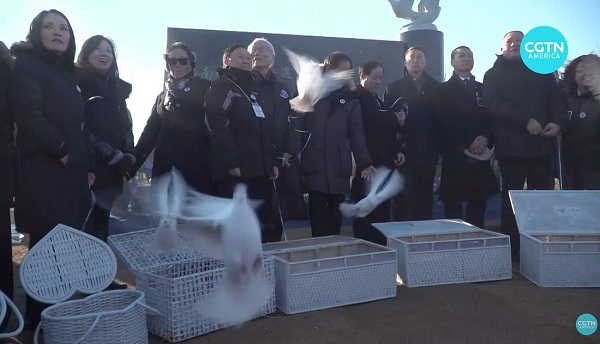conflict
Biden gives green light for Ukraine to shoot US-provided missiles into Russian territory

From LifeSiteNews
This is a major escalation of NATO engagement, likely intended to provoke Russia to strike alternate targets.
According to Politico and the New York Times the Biden administration has given Ukraine approval to launch U.S.-provided missiles into Russia. This is a major escalation of NATO engagement, likely intended to provoke Russia to strike alternate targets. The people inside Ukraine responsible for using these U.S. provided weapons are likely not Ukrainian.
CTH is in an unusually serendipitous position to analyze how Russia is responding to this shift in U.S. position. The morale inside Russia is very high amid the military-age population. The recruitment efforts of the Russian government appear to be numerous and very effective.
There are thousands of newly enlisted military personnel very visible in/around training facilities. There is no apparent tension discernable. Overall Russia appears to take great pride in their military, and it is considered a matter of honor and pride to support them.
From Politico:
The Biden administration has quietly given Ukraine permission to strike inside Russia – solely near the area of Kharkiv – using U.S.-provided weapons, two U.S. officials and two other people familiar with the move said Thursday, a major reversal that will help Ukraine to better defend its second-largest city.
‘The president recently directed his team to ensure that Ukraine is able to use U.S. weapons for counter-fire purposes in Kharkiv so Ukraine can hit back at Russian forces hitting them or preparing to hit them,’ a U.S. official said, adding that the policy of not allowing long-range strikes inside Russia ‘has not changed.’
… In effect, Ukraine can now use American-provided weapons, such as rockets and rocket launchers, to shoot down launched Russian missiles heading toward Kharkiv, at troops massing just over the Russian border near the city, or Russian bombers launching bombs toward Ukrainian territory. But the official said Ukraine cannot use those weapons to hit civilian infrastructure or launch long-range missiles, such as the Army Tactical Missile System, to hit military targets deep inside Russia.
It’s a stunning shift the administration initially said would escalate the war by more directly involving the U.S. in the fight. But worsening conditions for Ukraine on the battlefield – namely Russia’s advances and improved position in Kharkiv – led the president to change his mind.
You can tell from the general vibe amid the officials of government, Russia is not playing around with their military approach toward previous NATO encroachment or the provocations by the U.S. The sense is that Russia is in this for the long haul and their structural changes in the aftermath of the sanction regime are not temporary. Russians overall are hard and resilient to the reality of things as they are, not as they would wish them to be.
Russia appears to be entirely prepared financially, sociologically, and economically to remain disconnected from the “West.” Asia and India are filling the economic void created by Western sanctions. Amid ordinary life, the general Russian sentiment seems to be one of acceptance to the geopolitical isolation.
In recent weeks, the push toward further conflict with Russia seemed to be diminishing; however, this direct action by Biden and the State Dept. puts the U.S. (NATO) in a more aggressive posture.
Hungarian Prime Minister Viktor Orbán opposes the escalation by NATO:
During a Friday interview on state radio, Orbán said that French President Emmanuel Macron’s stance that he wouldn’t rule out sending troops to Ukraine, as well as a NATO proposal that would allow Kyiv to strike military bases inside Russia with sophisticated long-range weapons provided by Western partners, risked escalating the war in Ukraine into a global conflict.
‘War is a monster that is constantly hungry, it must be fed, and it must be fed with money. And I see that the Americans and the Democratic government of the United States, and the leaders of the European Union, are ready to feed it,’ he said.
Reprinted with permission from the Conservative Treehouse.
Artificial Intelligence
AI Drone ‘Swarms’ Unleashed On Ukraine Battlefields, Marking New Era Of Warfare


From the Daily Caller News Foundation
Artificial intelligence-powered drones are making their first appearances on the battlefield in the Russia-Ukraine war as warfare creeps closer to full automation.
In bombardments on Russian targets in the past year, Ukrainian drones acting in concert were able to independently determine where to strike without human input.
It’s the first battlefield use of AI “swarm” technology in a real-world environment, a senior Ukrainian official and Swarmer, the company who makes the software, told the Wall Street Journal in a Tuesday report. While drones have increasingly defined modern battlefields, swarms until now had been confined to testing rather than combat.
“You set the target and the drones do the rest,” Swarmer Chief Executive Serhii Kupriienko told the WSJ. “They work together, they adapt.”
So far, the Swarmer technology has been used hundreds of times to target Russia assets, but was first used a year ago to lay mines on the front, the Ukrainian official told the WSJ. The software has been tested with up to 25 drones at once, but is usually utilized with only three.
Kupriienko told the WSJ that he was preparing to test up to 100 drones at once with the linking software.
A common arrangement used on the battlefield includes one reconnaissance drone to scout out the target and two explosive drones delivering the payload on target, the official told the WSJ.
While Western nations such as the U.S., France and the United Kingdom are also pursuing drone swarm technology, they have not deployed swarm technology on the battlefield the way Ukraine has, according to the WSJ. Currently, autonomous weapons are not regulated by any international authority or binding agreement, but ethical concerns around the technology has led many to call for increased regulation of weapons like the Swarmer system.
The Ukrainian Ministry of Foreign Affairs did not immediately respond to the Daily Caller News Foundation’s request for comment.
conflict
Trump Pentagon Reportedly Blocking Ukraine From Firing Western Missiles Deep Into Russia


From the Daily Caller News Foundation
The Department of Defense has spent months blocking the Ukrainian military from using American and British-made missiles to hit targets deep inside Russia, The Wall Street Journal reported Sunday, citing unnamed U.S. officials.
Undersecretary of Defense for Policy Eldridge Colby reportedly designed the procedure to review requests to carry out the long-range strikes with weapons that are either of U.S. origin or that require American intelligence or use components provided by the U.S., according to the WSJ. Secretary of Defense Pete Hegseth reportedly has the final say on whether Ukrainian forces can use the MGM-140 ATACMS (Army Tactical Missile System) to hit targets in Russia.
The reported blocks on missile strikes coincides with a Trump administration effort to broker a peace deal between Russia and Ukraine. A Pentagon spokesperson declined to comment further on the matter.
BREAKING: President Vladimir Putin reacts to B-2 Flyover pic.twitter.com/1mzVn7DxlW
— Jack Poso 🇺🇸 (@JackPosobiec) August 15, 2025
The Biden administration allowed Ukraine to carry out strikes with ATACMS in November, weeks after President Donald Trump won the 2024 election, the New York Times reported. Trump criticized the move during a December interview with Time magazine.
“It’s crazy what’s taking place. It’s crazy,” Trump said. “I disagree very vehemently with sending missiles hundreds of miles into Russia. Why are we doing that? We’re just escalating this war and making it worse. That should not have been allowed to be done.”
Trump and Russian President Vladimir Putin met in Alaska on Aug. 15 for a summit meeting during which Trump sought to secure a cease-fire in Russia’s war with Ukraine. As Trump greeted Putin, a B-2A Spirit stealth bomber and several fighters carried out a flyover of Elmendorf Air Force Base.
Trump met with Ukrainian President Volodymyr Zelensky and major European leaders on Aug. 18 to update them on the summit.
In July, Trump reached an agreement with NATO where members of the alliance would purchase weapons, including MIM-104 Patriot surface-to-air missiles, and donate them to Ukraine.
-

 espionage2 days ago
espionage2 days agoCarney Floor Crossing Raises Counterintelligence Questions aimed at China, Former Senior Mountie Argues
-

 Business2 days ago
Business2 days agoTaxing food is like slapping a surcharge on hunger. It needs to end
-

 Business1 day ago
Business1 day agoThere’s No Bias at CBC News, You Say? Well, OK…
-

 Energy2 days ago
Energy2 days ago75 per cent of Canadians support the construction of new pipelines to the East Coast and British Columbia
-

 Health1 day ago
Health1 day agoFDA warns ‘breast binder’ manufacturers to stop marketing to gender-confused girls
-

 Uncategorized13 hours ago
Uncategorized13 hours agoMortgaging Canada’s energy future — the hidden costs of the Carney-Smith pipeline deal
-

 Agriculture1 day ago
Agriculture1 day agoSupply Management Is Making Your Christmas Dinner More Expensive
-

 Daily Caller1 day ago
Daily Caller1 day agoTrump Reportedly Escalates Pressure On Venezuela With Another Oil Tanker Seizure









